Updated Highlights of Comprehensive Survey of Iran’s Advanced Centrifuges - March 2023 [1]
Background
- This report summarizes and assesses information in the International Atomic Energy Agency’s (IAEA) quarterly report for February 28, 2023, Verification and monitoring in the Islamic Republic of Iran in light of United Nations Security Council resolution 2231 (2015) and the quarterly safeguards report for March 4, NPT Safeguards Agreement with the Islamic Republic of Iran.
- Iran continues to deploy advanced centrifuges at its three enrichment facilities at Natanz and Fordow in violation of the limitations outlined in the Joint Comprehensive Plan of Action (JCPOA).
- In the event of a revival of the JCPOA, under rules embodied in the existing JCPOA, Iran would be permitted to mothball its advanced centrifuges, shortening Iran’s potential breakout timeline and increasing its ability to build up its capability should the deal collapse or once enrichment capacity restrictions phase out starting in 2025.
- Since February 2021, Iran has not provided declarations about its production and inventory of centrifuge rotor tubes, bellows, and rotor assemblies or allowed IAEA verification, as specified in the JCPOA. While data and recordings were collected by IAEA surveillance equipment up until June 2022, the IAEA has not had access to those data and recordings, and since June 2022, when Iran removed the cameras, no such recordings exist. Consequently, the IAEA has had no ability to take inventory.
- Iran has been producing near 60 percent highly enriched uranium (HEU) in advanced centrifuge cascades since April 2021.
Findings
- Since the last quarterly report in November, based on data in the most recent quarterly report, Iran installed 1248 advanced centrifuges, all at the Natanz Fuel Enrichment Plant (FEP). Of these, 1044 are IR-2m centrifuges, organized in six cascades. The rest were IR-4 centrifuges, in one cascade.
- Overall, Iran has 12,994 centrifuges installed at all three of its enrichment plants; 5763 advanced centrifuges of various types and 7231 IR-1 centrifuges.
- Between February 2022 to February 2023, Iran nearly tripled its annual deployment of advanced centrifuges to over 3500 advanced centrifuges deployed during that time span, compared to the deployment of about 1200 advanced centrifuges observed between February 2022 and February 2021, which itself was double that from the year prior, February 2020 to February 2021, during which roughly 500 advanced centrifuges were deployed.
- Iran now has over 3700 IR-2m centrifuges installed, which exceeds not only the 1000 IR-2m centrifuges installed prior to the JCPOA, but also the 3000 IR-2m centrifuges planned prior to the JCPOA. The origin of the newly deployed IR-2m centrifuges could not be determined. They may have been produced since 2018 or produced prior to 2016. In the former case, Iran may have greatly expanded its advanced centrifuge production rate. In the latter case, Iran would have retrieved them from a secret storage location not declared under the admittedly loose rules of the JCPOA. The latter case would confirm a long-held suspicion that prior to the JCPOA, Iran had manufactured 3000 IR-2m centrifuges for installation at the FEP but only installed about 1000 of them, hiding the rest.
- In November 2022, Iran announced its plan to install 14 IR-6 centrifuge cascades at the Fordow Fuel Enrichment Plant Fordow (FFEP), where six IR-6 cascades would replace six currently operating IR-1 centrifuge cascades, and result in a total of 16 IR-6 cascades, or 2656 IR-6 centrifuges, at Fordow. The installation of these extra IR-6 centrifuges has yet to begin, but preparations are ongoing.
- If Iran finished the installation of these planned IR-6 centrifuges, the potential of the FFEP to be used in a breakout to weapon-grade uranium would change drastically, posing a severe breakout risk in a deeply buried facility. With all 16 IR-6 centrifuge cascades working together to make 90 percent enriched uranium, Fordow could rapidly produce weapon-grade uranium from Iran’s existing stock of 20 percent enriched uranium, enough for one nuclear weapon in nine days, and enough for a total of three nuclear weapons in less than a month. The use of its stock of 60 percent enriched uranium in a breakout would add to these totals.
- On November 22, Iran began to use the two cascades of IR-6 centrifuges at the FFEP “in an interconnected mode” to produce 60 percent enriched uranium from 5 percent feed.
- In January, Iran may have purposely and temporarily increased the level of enrichment reached in the IR-6 cascades above 60 percent HEU, potentially gaining valuable experience in how to modify the two cascades to produce near-weapon-grade uranium.
- On January 21, 2023, during an unannounced inspection, IAEA inspectors found the IR-6 cascades operating in a way that was undeclared by Iran. The following day, the inspectors took environmental samples at the product sampling point and detected the presence of near 84 percent enriched uranium.
- With the new developments and plans at Fordow, the IR-6 appears to have emerged as Iran’s centrifuge of choice for HEU production . This choice is worrisome, since it is the type that requires the fewest for a secret enrichment plant among the IR-1, IR-2m and IR-4 centrifuges, has fewer design details available than the other production-scale centrifuges, and lacks credible information on the total number manufactured.
- Iran has met its announced goal of installing 21 cascades of IR-2m centrifuges. However, it has not met its goals for other advanced centrifuges. In addition to the 14 IR-6 cascades discussed above, Iran has yet to begin the installation of the remaining eight cascades of a set of 12 long-announced IR-4 centrifuge cascades at the Natanz FEP. During the last reporting period, Iran completed one additional cascade, the fourth of the set.
- On February 25, 2023, Iran announced to the IAEA a change in its design information for Fordow, allowing for either IR-1 or IR-6 centrifuge cascades. Thus, if Iran fails to make sufficient IR-6 centrifuges to outfit 14 cascades, it may install IR-1 cascades instead. Pending more concrete results, the Institute’s projection, in which it is assumed that all 14 cascades would be IR-6 centrifuges, is unchanged. However, this change in the design information does highlight the flexibility Iran is seeking and could perhaps indicate an inability to make the required number of IR-6 centrifuges.
- Based on Iran’s plans reported by the IAEA, the Institute projects that Iran plans on deploying about 3700 additional advanced centrifuges, reaching a total of 9479 advanced centrifuges. Iran did not provide a schedule of deployments and the Institute considers this at least a one-year, perhaps a two-year deployment plan, based on current understandings of Iran’s ability to manufacture and assemble centrifuges.
- Iran currently has a total installed nominal enrichment capacity of approximately 29,100 SWU per year, where advanced centrifuges account for almost 80 percent of the capacity, or 22,600 SWU per year, compared to the IR-1 centrifuges which account for about 6400 SWU per year. This exceeds any previously installed enrichment capacity, including before the JCPOA.
- A centrifuge assembly facility continues to be constructed underneath a mountain near the Natanz FEP. Its date of completion is unknown, although it may not be operational this year, perhaps not operational until sometime in 2024.2
- With Iran accelerating its advanced centrifuge deployments, uncertainties are growing in the estimated number of advanced centrifuges produced in excess of those deployed, increasing concern that Iran will again seek to build a clandestine enrichment plant, using advanced centrifuges manufactured in secret.
- The IAEA newly reports that it can no longer reestablish continuity of knowledge about Iran’s activities under a revived JCPOA, including the production of advanced centrifuges, and says it would need to establish a new baseline altogether, requiring access to extensive records. It reports, “Any future baseline for [JCPOA] verification and monitoring activities would take a considerable time to establish and would have a significant degree of uncertainty.”
- Over the weekend of March 4th, IAEA Director General Rafael Grossi traveled to Tehran for high-level meetings and returned with an IAEA/Iran Joint Statement. The statement is vague on Iranian commitments; however, Grossi also received verbal commitments from Iran, which he detailed during two press conferences following the visit. One commitment was to reestablish monitoring at sites involved in making and assembling centrifuge rotors and bellows.
Advanced Centrifuge Deployments
In the last three years, Iran has been deploying advanced centrifuges across all three enrichment plants–the Natanz above-ground Pilot Fuel Enrichment Plant (PFEP), the much bigger, below-ground Natanz Fuel Enrichment Plant, and the deeply buried Fordow Fuel Enrichment Plant, following a lull of three years created by the limits in the Joint Comprehensive Plan of Action (JCPOA). Starting in late 2020 or early 2021, it dramatically increased the number of deployed advanced centrifuges, with deployment rates skyrocketing between September 7 and November 10, 2022 when it deployed ten advanced centrifuge cascades at a rate of about one per week. Since then, Iran has made additional, ambitious announcements, calling for the installation of additional 29 advanced centrifuge cascades. Although the rate of deployment subsequently decreased, Iran added 7 cascades, or a total of 1248 advanced centrifuges between November 10, 2022 and February 28, 2023, reaching a total of 5763 installed advanced centrifuges.
Iran has demonstrated a clear commitment to phase out its first-generation IR-1 centrifuge by focusing on the deployment of advanced centrifuges. The jumps in deployments over the last six months means Iran is moving towards achieving its long-announced plan of having a total installed enrichment capacity of about 125,000 SWU per year.
Figure H.1 shows the number of advanced centrifuges deployed from 2011 onwards through February 2023, with a projection based on Iran’s most recent announcements.3 The Institute’s projection, based on Iran’s plans announced to the IAEA in November 2022, calls for the deployment of about 3700 additional advanced centrifuges, bringing the projected total to 9479 advanced centrifuges. The slight change in the projected number compared to the Institute’s December 2022 projection reflects small changes at the PFEP. No additional plans were announced in February 2023 in the most recent IAEA report.
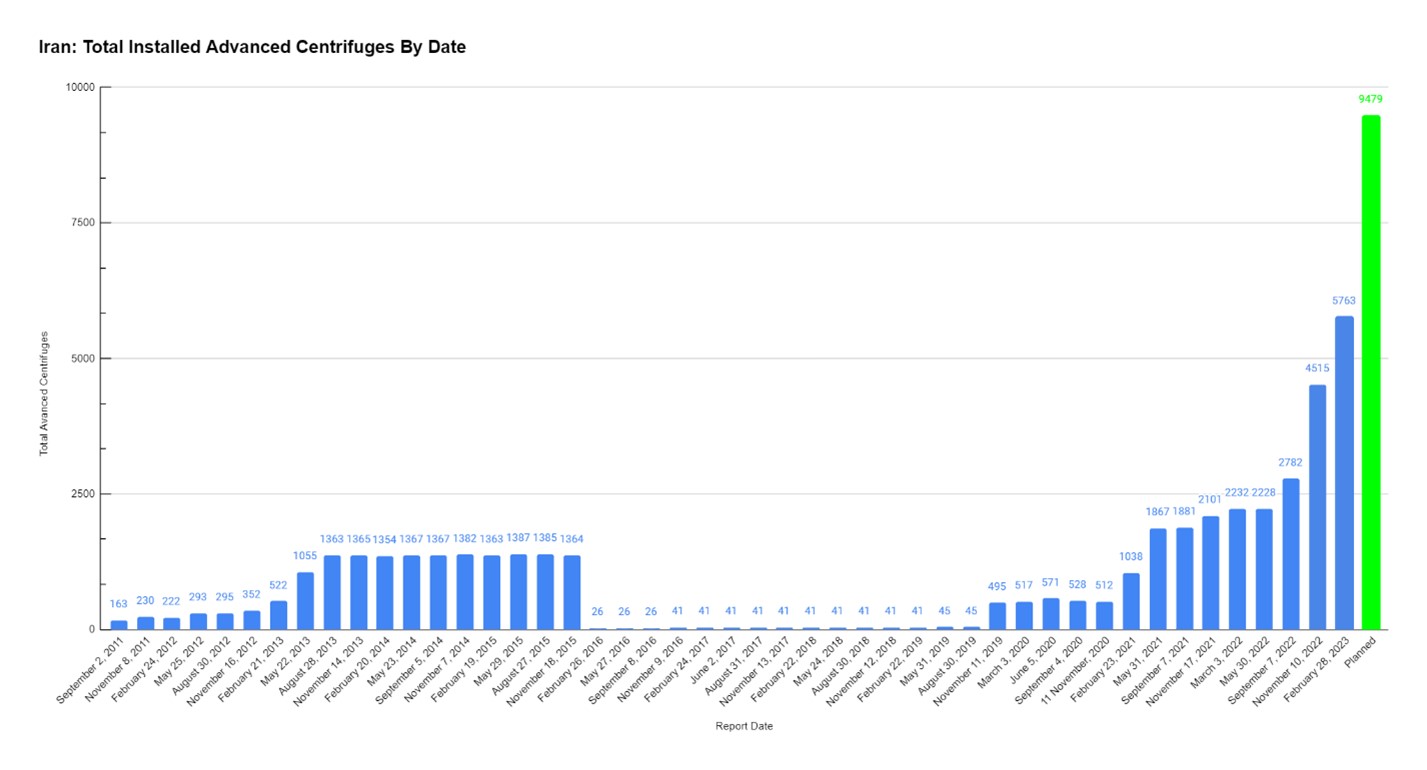
Figure H.1. Iran’s quarterly number of installed advanced centrifuges at its three enrichment plants, with a projection without a specified schedule, but likely spanning more than one year, perhaps late 2023 and 2024 (last vertical bar). (The number of IR-1 centrifuges are ignored in this graph but see Figure H.2 for a complete breakdown of the situation today.) Planned in the context of this graph means firmly announced plans filed with the IAEA; it does not reflect Iran’s long-term plan to deploy sufficient centrifuges to have a total enrichment capacity of 125,000 SWU/year.
Overall, Iran’s deployments have focused on its three most successful advanced centrifuge types: the IR-2m, the IR-4, and the IR-6. However, the centrifuges installed over the last six months are primarily IR-2m centrifuges, about 2610 centrifuges in number, meaning that Iran has now close to 3749 IR-2m centrifuges installed across its three enrichment plants. Iran also completed installation of a fourth IR-4 cascade at the FEP for an estimated total of 887 IR-4 centrifuges installed. No new IR-6 centrifuges had been or were being installed as of February 28, 2023, thus that number remains at 1052 centrifuges, with minor changes in deployment at the PFEP.
Because of unclear Iranian practices on the number of advanced centrifuges produced versus deployed, and less Iranian transparency at its centrifuge manufacturing and assembly sites since February 2021, it is difficult to estimate to what extent the recent advanced centrifuge deployments reflect increased manufacturing and assembly capacity or deployments of stored IR-2m centrifuges not disclosed earlier. But the deployments are substantial and suggest a large source of advanced centrifuges, whether newly made or taken from a secret storage location. Iran may have largely recovered from attacks on its advanced centrifuge manufacturing and assembly capabilities in 2020 and 2021 and in doing so expanded its manufacturing and assembly capability. The destroyed plants included the Natanz Iran Centrifuge Assembly Center (ICAC) and a key workshop at the centrifuge manufacturing plant at a site called TABA Karaj (also known as TESA), situated near Karaj. The ICAC was built to have a capacity to make an estimated 8000 advanced centrifuges per year. After the attacks, Iran’s manufacturing and assembly capacity appears to have been substantially reduced, down to a level of several hundred advanced centrifuges per year. A temporary assembly facility was inaugurated at Natanz in April 2021, about nine months after the attack on the ICAC. Shortly after, an attack occurred on Iran’s centrifuge manufacturing capabilities at Karaj. Iran subsequently moved manufacturing capabilities to Natanz and to an unknown site at or near Esfahan. But it is unclear if these new capabilities provide Iran the ability to make thousands of centrifuges each year, complicating any explanation of the large deployment of IR-2m centrifuges since August 2022. Further, it remains unknown how Iran plans to make the nearly 3700 additional advanced centrifuges it would install.
With Iran accelerating its advanced centrifuge deployments, uncertainties are growing in the estimated number of advanced centrifuges produced in excess of those deployed, adding concern to the possibility that Iran will again seek to build a clandestine enrichment plant, using advanced centrifuges manufactured in secret.
The IAEA shares concerns about the uncertainties. In the March 4, 2023, Iran NPT safeguards report, the IAEA stated “restoration of the safeguards-related knowledge in relation to the production and inventory of centrifuge rotors and bellows” is one of the issues “indispensable for the Agency to be able to provide credible assurances of the peaceful nature of Iran’s nuclear programme.”
The Joint Statement and Iran’s stated commitment to re-install IAEA monitoring of the production of centrifuge rotors and bellows is a useful step; however, large gaps remain in the IAEA’s knowledge of Iran’s centrifuge production and assembly activities. As of February 2023, the IAEA assesses that the gaps are so large that it would “not be able to re-establish continuity of knowledge in relation to the production and inventory of centrifuges, rotors and bellows“ and a new baseline would have to be established, noting it would require extensive collaboration from Iran and would still face uncertainties. Establishing centrifuge and rotor assembly inventories in earlier years and again prior to the implementation of the JCPOA in 2016 faced similar challenges and ultimately proved unsuccessful despite best IAEA efforts.
HEU Production in Advanced Centrifuges
Since April 2021, Iran has been producing near 60 percent HEU from near 5 percent LEU feed in two cascades of advanced centrifuges, one IR-4 and one IR-6 cascade, at the PFEP. Over the nearly two-year period, Iran has frequently changed the operation of these cascades, including interconnecting the two cascades in different ways. In November 2022, Iran started to produce near 60 percent enriched uranium, also in two cascades of IR-6 centrifuge cascades at the FFEP. These two cascades were also reported as being interconnected and using near 5 percent LEU feed. As of February 2022, Iran continues to enrich uranium to 60 percent HEU in the two cascades at the PFEP and the two IR-6 centrifuge cascades already installed at the FFEP. As of February 12, the four cascades together have produced a total of 87.5 kg uranium enriched up to 60 percent (uranium mass). The monthly average production rate of 8 kg (uranium mass) during the last reporting period represents an average annual production capacity of 96 kg (uranium mass).
Recent findings from the IAEA indicate that Iran may have temporarily increased the enrichment level achieved in the two IR-6 centrifuge cascades beyond 60 percent HEU. On January 21, 2023, the IAEA conducted an unannounced inspection at the FFEP, during which it found that the two cascades were operating in a way that was not declared to the IAEA. A day after, on January 21, inspectors took environmental samples that revealed the presence of near 84 percent HEU at the product sampling point. Iran’s answers about this anomaly did not satisfy the IAEA, which has continued probing Iran for more credible answers. While fluctuations can occur during the startup of a cascade, when flow levels of UF6 are low, previous fluctuations in the production of near-60 percent HEU from near 5 percent LEU feed were detected and reported by Iran. Combined with the fact that the IAEA took the environmental sample detecting the near 84 percent HEU a day after detecting the undeclared operation, many doubt that the high enrichment level was accidental. There are no indications that Iran accumulated near 84-percent HEU product, rather, it appears that Iran was conducting experiments with modifying the cascades already enriching to 60 percent HEU to reach higher enrichment levels, possibly trying to do so without getting noticed by the IAEA. In a press conference, Grossi stated the IAEA inspectors will be able to determine if this was the result of a “one-time shot” or a “more deliberate effort.”
Closer Look at the Numbers
Figure H.1 shows a steady increase in the number of advanced centrifuges until 2013, followed by a steady level, and then a sharp drop in 2016, when the JCPOA was implemented with a focus on limiting advanced centrifuge research and development, at least temporarily. That number started to increase again in the fall of 2019, after Iran began to violate the JCPOA, but at a faster rate than prior to the JCPOA, reaching unprecedented deployment levels in May 2021 after a sharp increase after late 2020. For nearly two years, the number of deployed advanced centrifuges has exceeded the number deployed prior to the JCPOA. As of February 2021, Iran had approximately 1038 advanced centrifuges installed at its three enrichment plants. A year later, by the end of February 2022, the total number had more than doubled to 2232. Yet another year later, as of February 2023, Iran has 5763 advanced centrifuges, about five times the amount it had in February 2021.
Table H.1 shows that since February 2019 (ignoring advanced centrifuges installed earlier), Iran installed a total of 5722 advanced centrifuges, deploying multiple cascades of IR-2m, IR-4, and IR-6 centrifuges, some taken from storage, many newly made, and a variety of other advanced centrifuges in partial cascades. The first full cascades of advanced centrifuges were deployed after August 2019, followed by a lull in deployments for most of 2020, keeping the monthly averages low for the first two years, before almost 1194 advanced centrifuges were installed between February 2021 and February 2022. Over half of the 5763 currently installed advanced centrifuges–3531 advanced centrifuges–were installed over the last year, between February 2022 and February 2023.
Table H.1 Advanced Centrifuge Deployment, Year Over Year, and Monthly Average
Table H.1. Yearly advanced centrifuge deployment numbers and monthly average across all three enrichment facilities. From November 2018 until February 2019, the number of advanced centrifuges remained the same and matched the pre-November 2018 level. As a result, the start of the year in the table was adjusted from the last centrifuge report from November to February.
Iran has continued to reiterate its determination to increase the number of deployed advanced centrifuges over the next several months. On November 19, 2022, Iran announced in an updated Design Information Questionnaire (DIQ) to the IAEA that it intends to deploy a total of 21 cascades of IR-2m and 12 cascades of IR-4 centrifuges at Natanz FEP. As of February 2023, Iran has achieved the 21 cascades of IR-2m centrifuges, but it has not installed eight of the 12 IR-4 cascades; these would add another 1392 advanced centrifuges. The projected total installed centrifuges for the FEP is 6264 advanced centrifuges.
At the Fordow Fuel Enrichment Plant (FFEP) no new advanced centrifuges have been installed since the March 2022 reporting period, but a dramatic announcement has been made: Iran intends to almost fully outfit the plant with IR-6 centrifuges only, replacing the six IR-1 cascades currently present and installing 14 IR-6 centrifuge cascades, for a total of 16 IR-6 cascades containing an estimated 2656 centrifuges at the FFEP, where eight of the new cascades will be placed in Unit 1 at the FFEP and six IR-6 cascades will replace the six IR-1 cascades in Unit 2. As reported in the February 2023 IAEA report, Iran amended its design information, apparently to allow for the case where it cannot produce enough IR-6 centrifuges and would instead install IR-1 centrifuges. However, pending new developments, namely Iran’s failure to install the desired number of IR-6 centrifuges, the Institute’s projection continues to assume that all additional 14 cascades would contain IR-6 centrifuges. The preparation of Unit 1 is in progress but installation of centrifuges has yet to begin.
If all 16 IR-6 centrifuge cascades were installed as planned, Fordow could rapidly produce weapon-grade uranium from stocks of 4.5 and 20 percent enriched uranium. (The production of 90 percent from 60 percent enriched uranium could be accomplished in less than two weeks in a few cascades, as discussed in other Institute reports.) With the 20 percent stock listed in the latest IAEA report, Fordow could produce 25 kg of WGU, enough for at least one nuclear weapon, in nine days, and enough for a total of three nuclear weapons in about 27 days. If Fordow used only the stock of two to five percent enriched uranium, listed in the latest IAEA report, it could produce enough weapon-grade uranium for one nuclear weapon in 1.4 months and enough for two by the end of three months. If both stocks are used sequentially, Fordow could produce enough WGU for five nuclear weapons in four months. Thus, Fordow, outfitted with a full complement of IR-6 centrifuges would by itself pose a severe breakout threat.
On November 29, 2022, the IAEA reported that Iran announced plans to install additional IR-2m, IR-4, and IR-6 centrifuges in line 5 at the PFEP, however, no numbers were given publicly. The relocation of the IR-5 centrifuges in this line and the installation of the IR-4 and IR-6 has begun.
IR-2m, IR-4, and IR-6 Centrifuges
The most important advanced centrifuges today are the IR-2m, IR-4, and IR-6 centrifuges. One way to see the importance of these three centrifuges is to consider that they can replace the IR-1 centrifuges while utilizing the same existing cascade piping and feed and withdrawal systems at the Natanz and Fordow sites. In fact, Iran has announced that it will do just that: replace six IR-1 cascades at Fordow with six IR-6 cascades. One other notable recent development is that Iran has managed to deploy more IR-2m centrifuges at Natanz. In addition, Iran continues to be successful in evading national and international controls and sanctions with regards to materials needed for the IR-4 and IR-6 centrifuges.
When Iran started production of 60 percent highly enriched uranium in April 2021, the IR-4 and IR-6 centrifuges were chosen for this task, rather than the ones with which Iran had more operational experience, such as the IR-1 or IR-2m centrifuge. The IR-1 centrifuge has already been used for the production of 20 percent enriched uranium, and the IR-2m centrifuge has been operated in cascades for several years. Further, when choosing to install a cascade at Fordow with sub-headers easily modifiable for producing different levels of enrichment, Iran chose the IR-6 centrifuge. This modifiable cascade is one of two cascades that started to enrich uranium from near 5 percent LEU to up to 60 percent HEU on November 22, 2022, and was also involved in the production of HEU above 60 percent discussed above.
In terms of understanding the impact of these three centrifuges, a key value is their estimated average enrichment output when arranged into cascades of about 160-170 centrifuges, called production-scale cascades, the workhorse for enrichment in Iran. These estimated average outputs are less than theoretical values or single centrifuge measured values because of inefficiencies experienced during larger-scale cascade operation. The enrichment output of the IR-2m centrifuge when operating in a production-scale cascade is estimated in the main report (A Comprehensive Survey of Iran’s Advanced Centrifuges, December 2021, available here) at 3.67 SWU per year; the estimated value for the IR-4 centrifuge in a production-scale cascade is 3.3 SWU per year. The equivalent value for the IR-6 centrifuge is harder to discern from the available information, but an estimated value of approximately 5.25 SWU per year appears justified and reasonable for its average output in a production-scale cascade. In general, these more practical outputs are about 75 percent of their single machine theoretical values given in the main report. 4 In practice, lower average values result, due to centrifuge breakage, inefficient operation, or during the production of highly enriched uranium, such as production of 20 or 60 percent enriched uranium or weapon-grade uranium. The IR-6 centrifuge, as mentioned above, seems to be underperforming significantly. Nonetheless, the practical enrichment output of these three centrifuges is far higher than that of the IR-1 centrifuge, which has achieved average production-scale cascade values of 0.6-1.0 SWU per year per centrifuge.
Table H.2 Enrichment Output of Iran’s Key Advanced Centrifuges
Note: The enrichment output of the IR-6 centrifuge in production-scale cascades remains uncertain in general. However, in calculating total enrichment output in this report, which we identify as nominal, we are using the higher value of 5.25 SWU per year per centrifuge. The enrichment output unit in this table should not be confused with Iran’s non-standard enrichment output unit (called in Institute reports the uranium hexafluoride unit). Iran’s unit is significantly larger than the more conventional unit. An analogy would be using liters instead of gallons in front of a U.S. audience, perhaps with the intention to make a value appear larger than it is.
Enrichment Output of Advanced Centrifuges
Because of their far greater enrichment outputs, the installed advanced centrifuges, although many fewer in number, began in May 2021 to exceed the enrichment capacity of the several thousands of installed IR-1 centrifuges. As of February 2023, the advanced centrifuges numbered about 5763, still less than the number of deployed IR-1 centrifuges at Natanz and Fordow, but their nominal enrichment capacity is more than threefold the enrichment capacity of the 7230 deployed IR-1 centrifuges.
Figure H.2 provides a comparison between the make-up of Iran’s centrifuges in terms of number of installed centrifuges (top) compared to the make-up of Iran’s enrichment capacity (bottom).
Figure H.3 provides Iran’s total historical theoretical enrichment capacity at Natanz and Fordow, where the IR-1 capacity is in blue and advanced centrifuge capacity is in red. Iran’s current nominal enrichment capacity exceeds its total capacity prior to the JCPOA’s implementation, and the nature of that capacity is shifting predominately to advanced centrifuges.
If Iran reaches the projected number of about 9479 advanced centrifuges, they will have six times the enrichment capacity of the currently deployed IR-1 centrifuges. This advanced centrifuge capacity will also be more than double that of all of Iran’s estimated 16,000 IR-1 centrifuges—deployed and stored—with only two-thirds the number of centrifuges. This comparison ignores any stored advanced centrifuges.
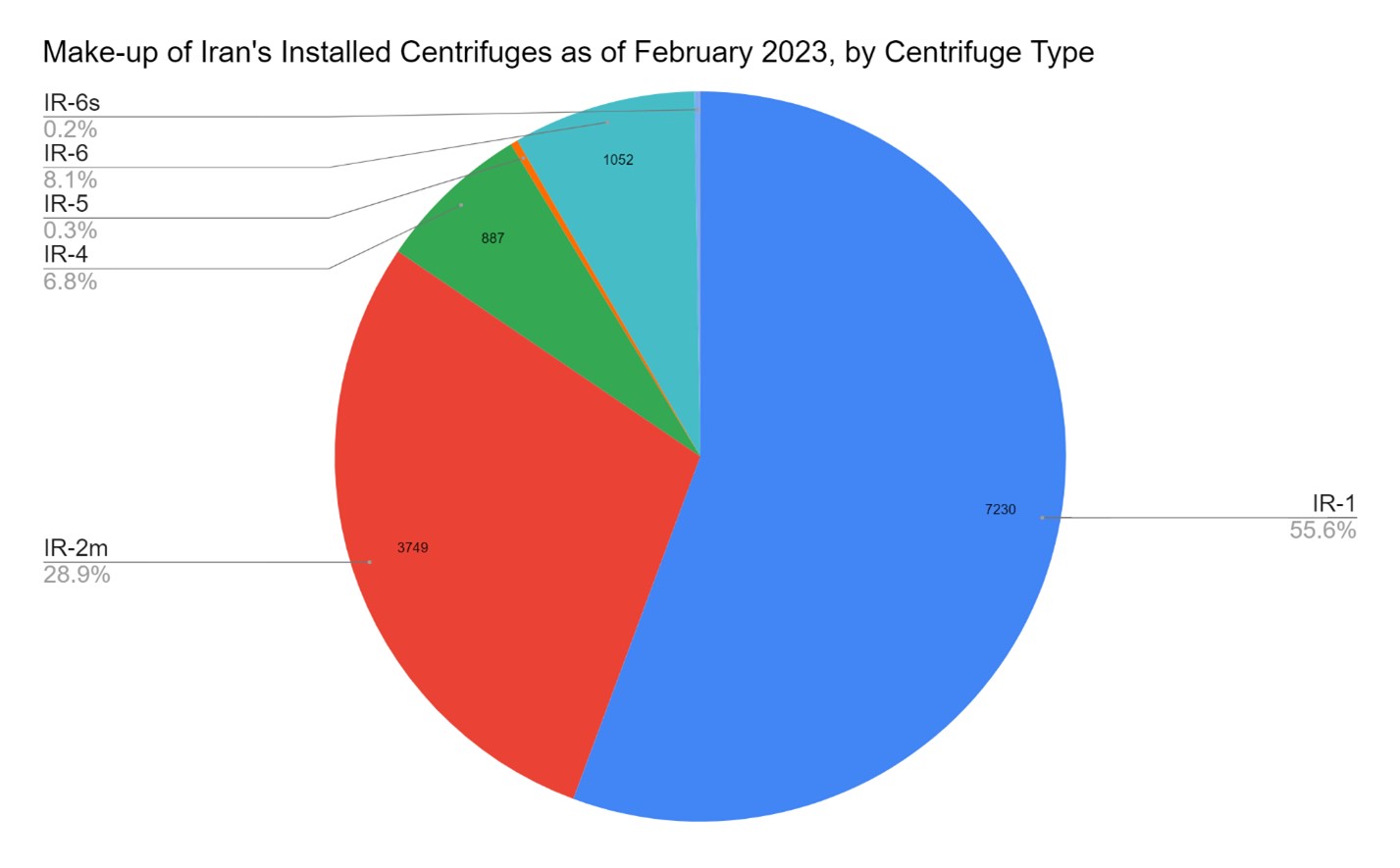
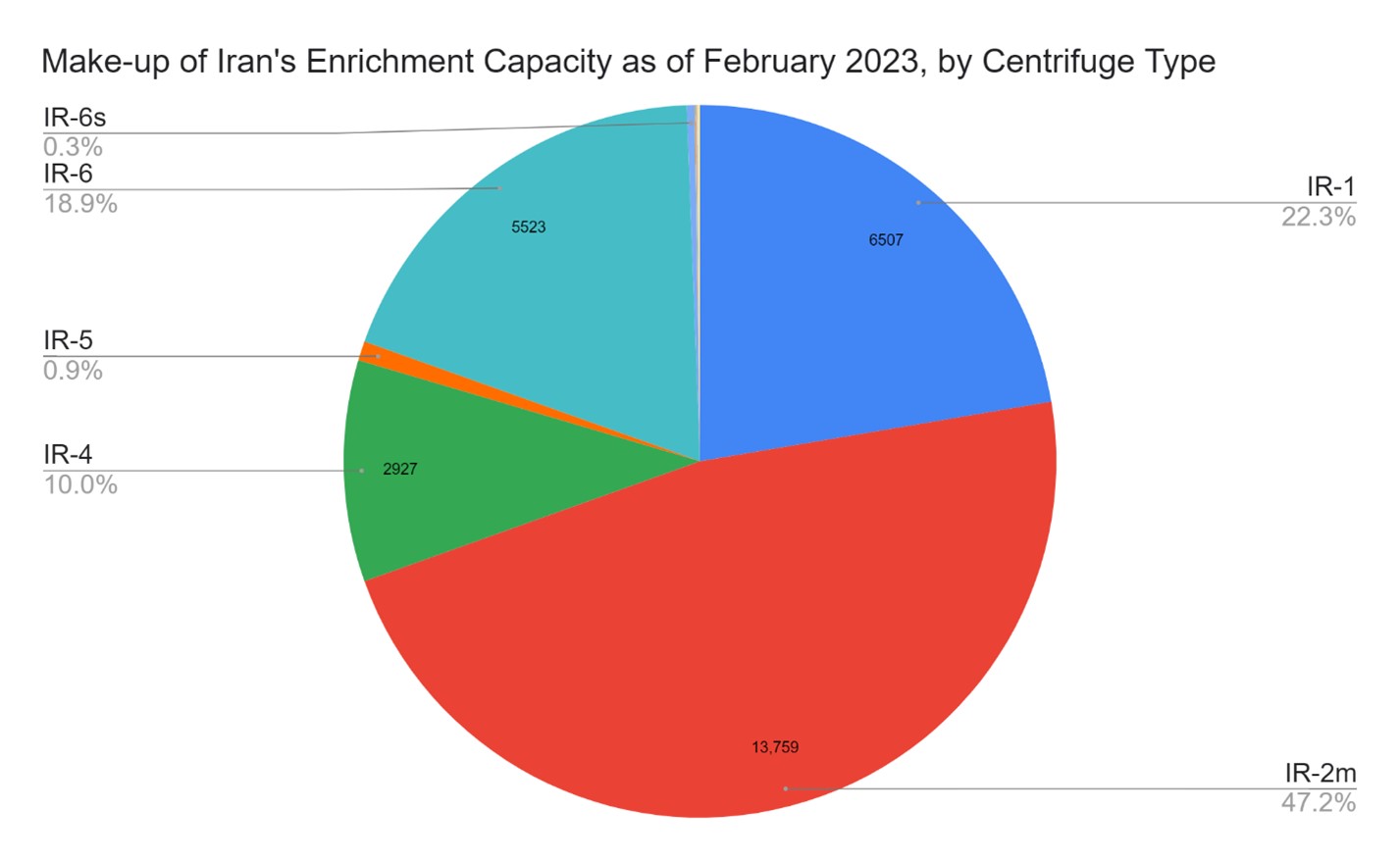
Figure H.2. Top: The fraction by type and number of Iran’s installed centrifuges at all facilities as of February 2023. The IR-7 (1 installed), IR-8 (1 installed), IR-8B (1 installed), IR-9 (1 installed) centrifuge types are represented on this graph, however, the respective counts are too few to be seen. Bottom: The make-up of Iran’s total installed enrichment capacity in SWU/year organized by centrifuge type. Despite the IR-1 accounting for more than half of the total installed centrifuges in terms of number, it only accounts for about 22 percent in terms of the installed enrichment capacity. The IR-2m, IR-4, and IR-6 make up about 76 percent, and the IR-5 and IR-6s about less than 2 percent of the installed capacity. The other installed advanced centrifuge types contribute only slightly to the total capacity and are not annotated in the pie chart.
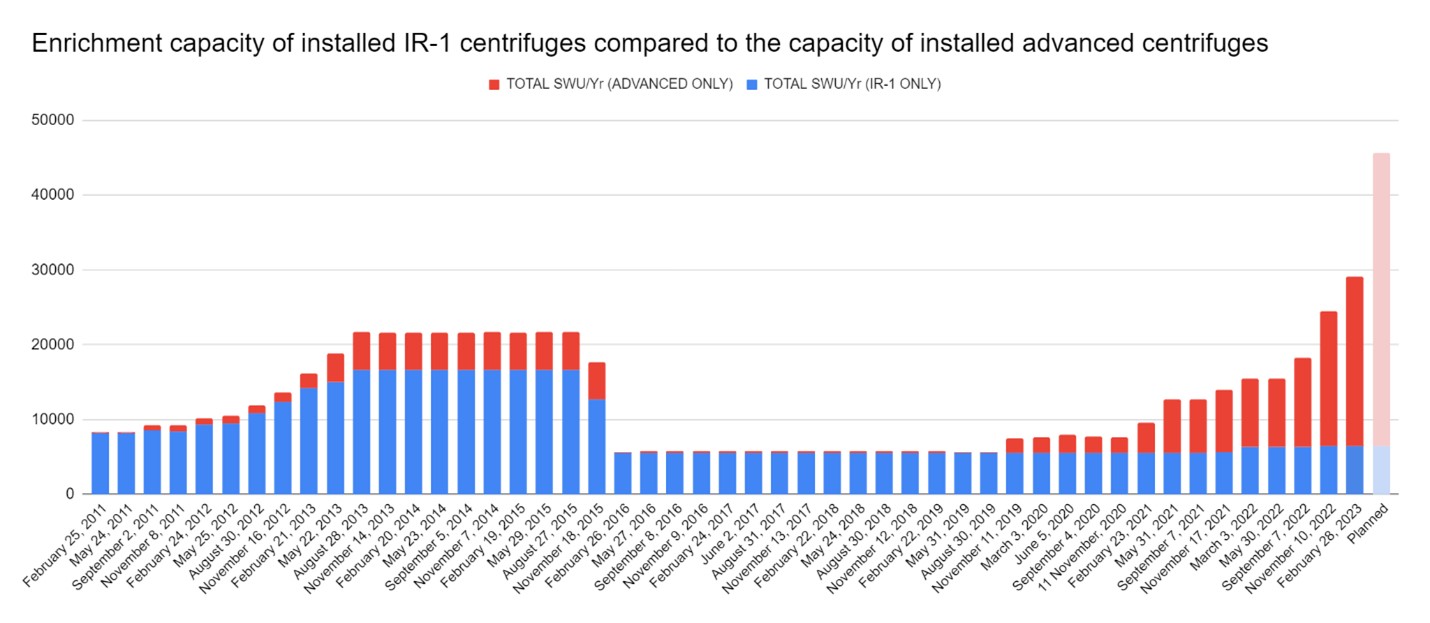
Figure H.3. Total enrichment capacity, by quarter, of the installed IR-1 and advanced centrifuges, with a projection on the far right of the graph. Planned in the context of this graph means firmly announced plans filed with the IAEA. It does not reflect Iran’s long-term plan to deploy sufficient centrifuges to have a total enrichment capacity of 125,000 SWU/year.
New, Large-Scale, Underground Centrifuge Assembly Facility
Construction of a new tunnel complex to house a replacement for the ICAC is progressing visibly. 5 Iran recently completed a fourth tunnel entrance - a second western entrance. The new tunnel complex will harbor halls more deeply buried than the Fordow uranium enrichment site, itself deeply buried, and features tunnel entrances that appear better protected as well. This site is expected to be large enough to produce centrifuges on the same scale as planned for the ICAC, namely thousands of advanced centrifuges per year. In fact, the estimated available floor space underneath the mountain ridge and between the visible tunnel entrances appears to significantly exceed that of the ICAC, leading to concerns that the site may have additional purposes, including housing a small enrichment facility containing advanced centrifuges. However, when the facility will be completed is unknown, although it may not be operational this year, perhaps not operational until sometime in 2024.
Sneak Out in a Clandestine Plant
More powerful advanced centrifuges make it easier for Iran to set up a secret enrichment plant, which would be smaller and host only a fraction of the centrifuges Iran would have needed in 2009, when it was trying to finish up and install IR-1 centrifuges at its secret enrichment plant near Qom (now known as Fordow FEP), designed to produce weapon-grade uranium. 6
Since only a relatively small number of advanced centrifuges would be needed to set up a secret and relatively powerful enrichment plant, unaccounted production of major parts for advanced centrifuges or whole rotor assemblies is cause for concern.
Apprehension about Iran building another secret enrichment plant will undoubtedly grow with time, absent negotiated limits and far more robust IAEA inspections than have functioned in Iran with or without the JCPOA. After all, the Natanz enrichment plant and the Fordow enrichment plant were built in secret until exposed, the latter as part of a covert military program to produce weapon-grade uranium, a facility that went undiscovered for upwards of six or seven years. 7 With advanced centrifuges, a secret plant could be smaller, more capable, and harder to discover, and this possibility should not be discounted. Adding to the risk, Iran could quickly divert stocks of safeguarded enriched uranium to such a secret site, speeding up a breakout at an unknown site.
Annex. Numbers of IR-2m, 4, and 6 centrifuges, historical deployments, by quarter
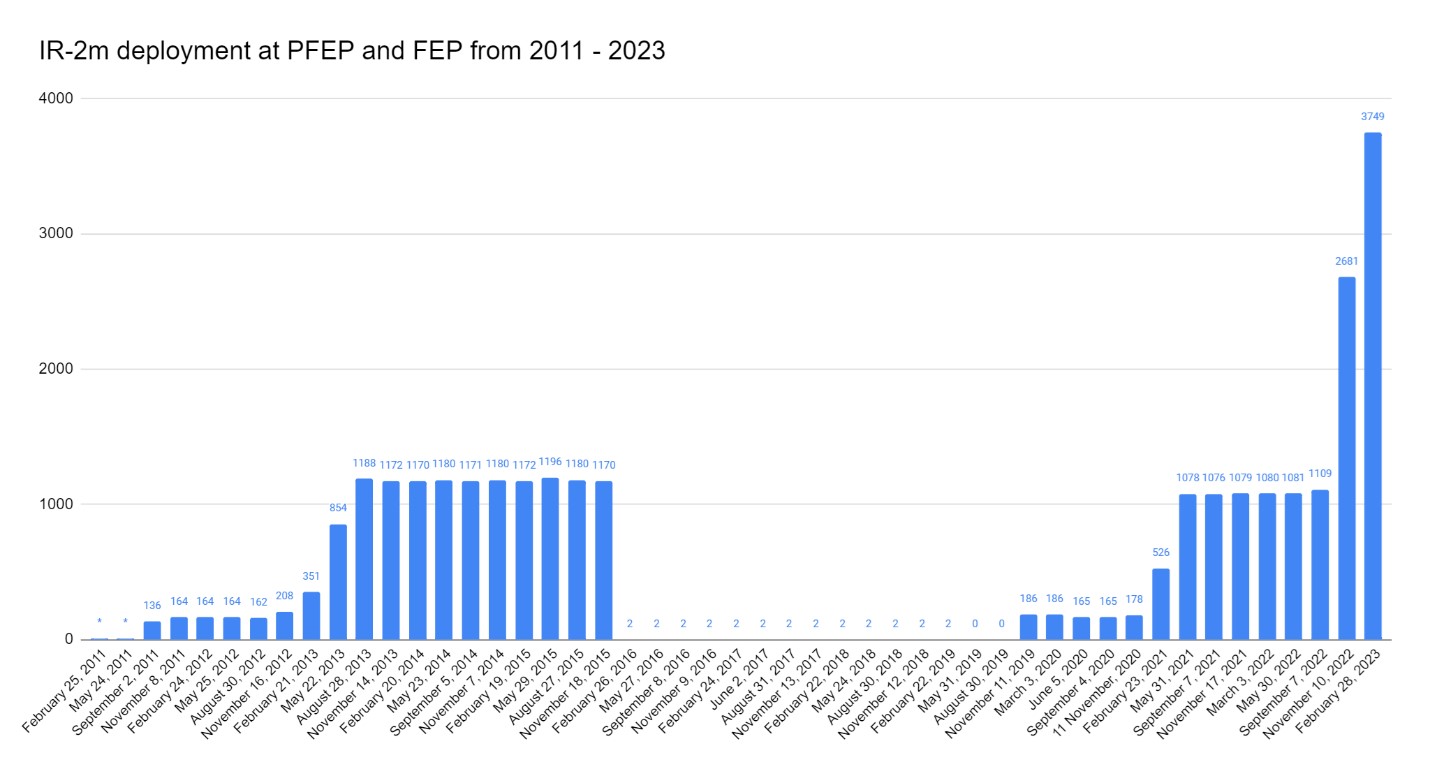
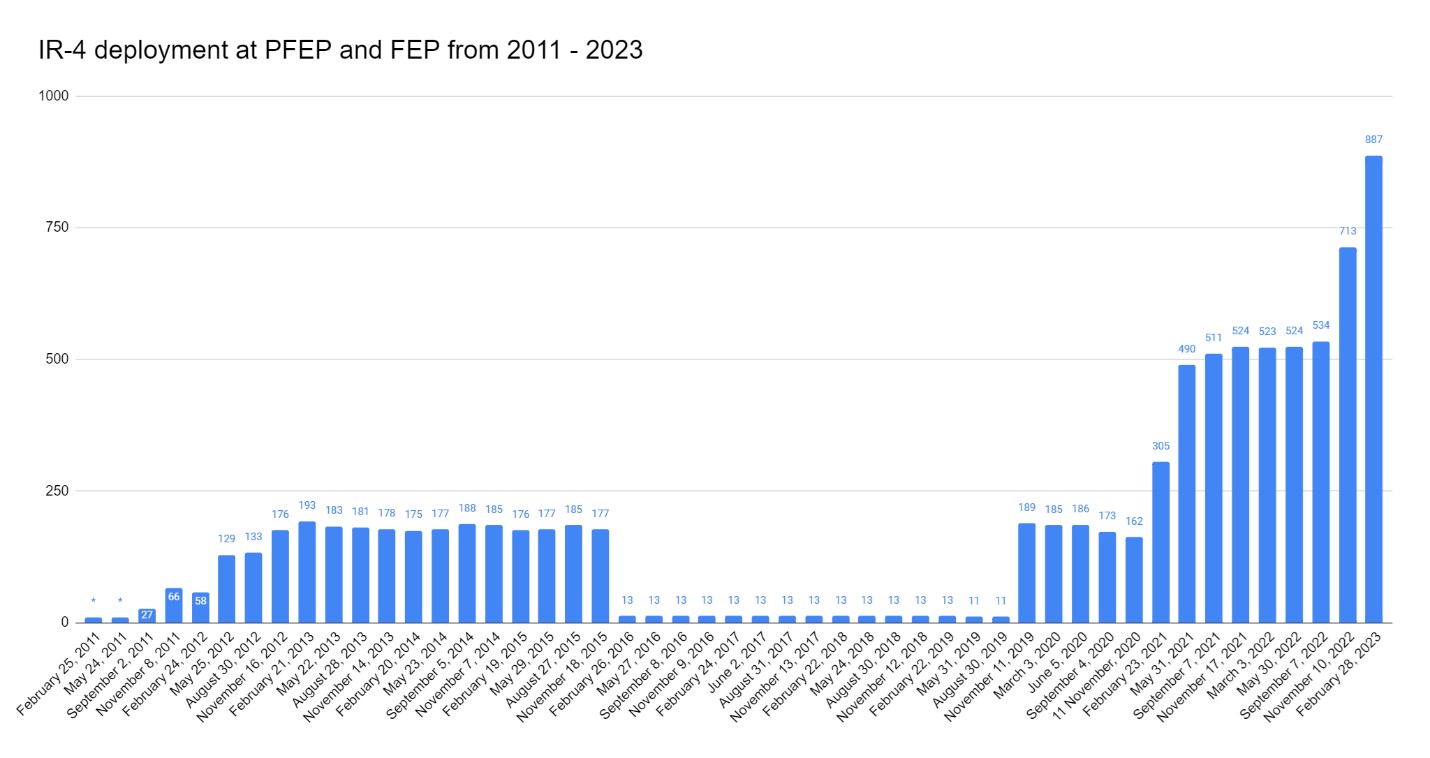
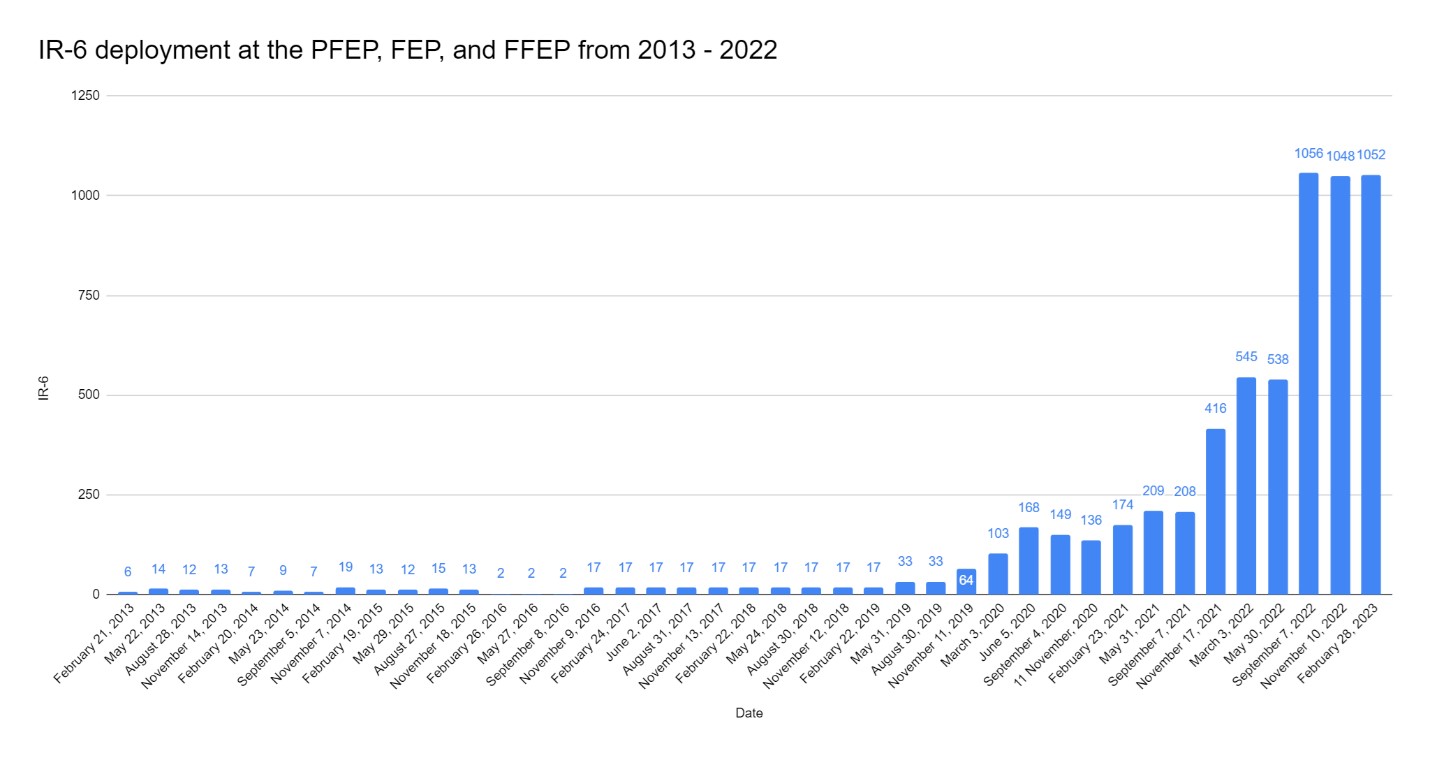
Images
Sources
1. David Albright, Sarah Burkhard, and Spencer Faragasso, “A Comprehensive Survey of Iran’s Advanced Centrifuges,” Institute for Science and International Security, December 2, 2021, https://isis-online.org/isis-reports/detail/a-comprehensive-survey-of-irans-advanced-centrifuges/8. ↩2. David Albright and Sarah Burkhard, “Imagery Update: Iran Adds Expected Fourth Tunnel Entrance to its Natanz Tunnel Complex,” Institute for Science and International Security, November 9, 2022, https://isis-online.org/isis-reports/detail/imagery-update-iran-adds-fourth-tunnel-entrance-to-its-natanz-tunnel. ↩
3. David Albright, Sarah Burkhard, Spencer Faragasso, and Andrea Stricker, “Analysis of IAEA Iran Verification and Monitoring Report - February 2023,” Institute for Science and International Security, March 3, 2022, https://isis-online.org/isis-reports/detail/analysis-of-iaea-iran-verification-and-monitoring-report-february-2023; IAEA Director General, Verification and monitoring in the Islamic Republic of Iran in light of United Nations Security Council resolution 2231 (2015), GOV/2023/8, February 28, 2023. ↩
4. As discussed in the main report, the associated single machine theoretical values for the IR-2m, IR-4, and IR-6 centrifuges are 4.4, 4.7, and 6.7 SWU/year/centrifuge, respectively. For comparison the single machine theoretical value for the IR-1 centrifuge is 1.4 SWU/year/centrifuge. ↩
5. David Albright, Sarah Burkhard, and John Hannah, “Iran’s Natanz Tunnel Complex: Deeper, Larger than Expected,” Institute for Science and International Security, January 13, 2022, https://isis-online.org/isis-reports/detail/irans-natanz-tunnel-complex-deeper-larger-than-expected; and “Imagery Update: Iran Continues to Harden its New Natanz Tunnel Complex.” ; and David Albright, Sarah Burkhard, “Imagery Update: Iran Adds Expected Fourth Tunnel Entrance to its Natanz Tunnel Complex,” Institute for Science and International Security, November 9, 2022,https://isis-online.org/isis-reports/detail/imagery-update-iran-adds-fourth-tunnel-entrance-to-its-natanz-tunnel. ↩
6. David Albright with Sarah Burkhard and the Good ISIS Team, Iran’s Perilous Pursuit of Nuclear Weapons, (Washington, DC: Institute for Science and International Security, 2021). ↩
7. Iran’s Perilous Pursuit of Nuclear Weapons. ↩








